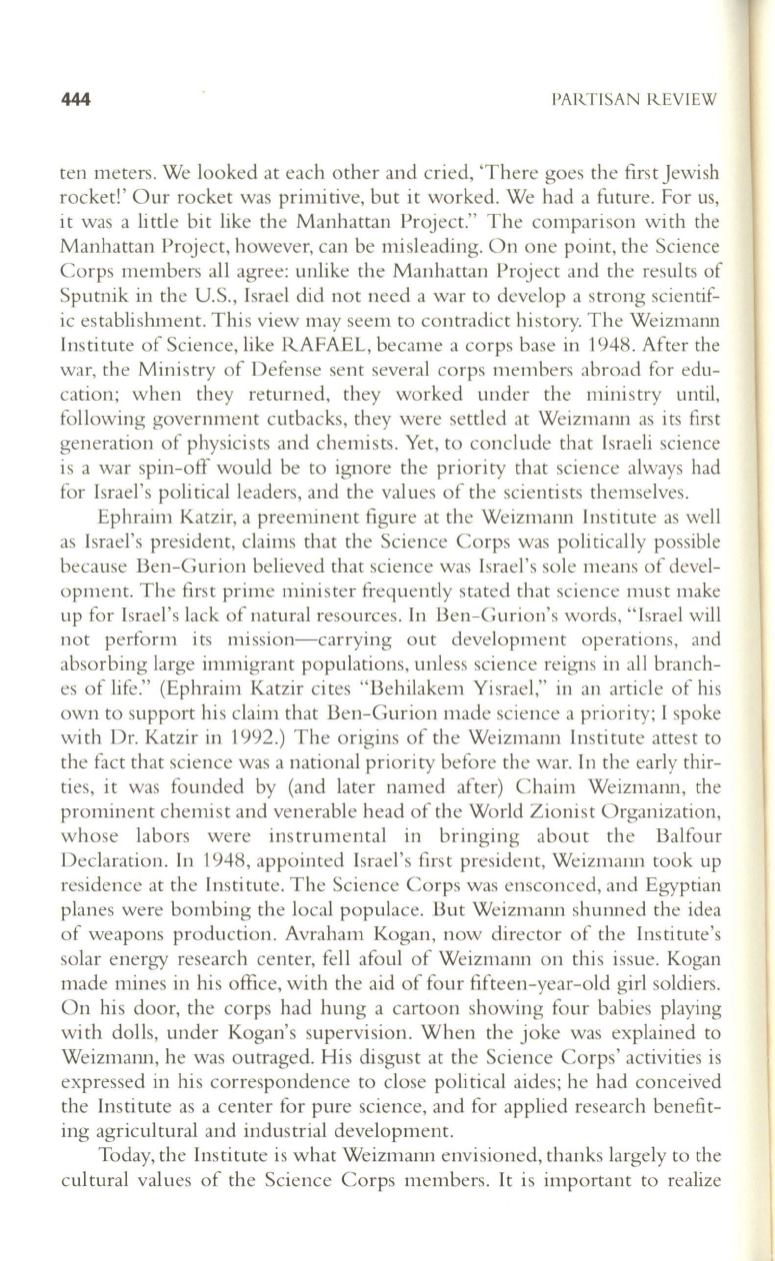
444
PARTISAN R.EVIEW
ten meters. We looked at each other and cried, 'There goes the first Jewish
rocket!' Our rocket was primitive, but it worked. We had a future. For us,
it was a little bit like the Manhattan Project." The comparison with the
Manhattan Project, however, can be misleading. On one point, the Science
Corps members all agree: unlike the Manhattan Project and the results of
Sputnik in the U.S., Israel did not need a war to develop a strong scientif–
ic establishment. This view may seem to contraclict history. The Weizmann
Institute of Science, like RAFAEL, became a corps base in 1948. After the
war, the Ministry of Defense sent several corps members abroad for edu–
cation; when they returned, they worked under the ministry until,
following government cutbacks, they were settled at Weizmann as its first
generation of physicists and chemists. Yet, to conclude that Israeli science
is a war spin-off would be to ignore the priority that science always had
for Israel's political leaders, and the values of the scientists themselves.
Ephraim Katzir, a preeminent figure at the Weizmann Institute as well
as Israel's president, claims that the Science Corps was poJi ticaJly possible
because Ben-Gurion believed that science was Israel's sole means of devel–
opment. The first prime minister frequently stated that science must make
up for Israel's lack of natural resources. In Ben-Gurion's words, "Israel will
not perform its mission-carrying out development operations, and
absorbing large immigrant populations, unless science reigns in all branch–
es of life." (Ephraim Katzir cites "Behilakem Yisrael," in an article of his
own to support his claim that Ben-Gurion made science a priority; I spoke
with Dr. Katzir in 1992.) The origins of the Weizmann Institute attest to
the fact that science was a national priority before the war.
In
the early thir–
ties, it was founded by (and later named after) Chaim Weizmann, the
prominent chemist and venerable head of the World Zionist Organization,
whose labors were instrumental in bringing about the Balfour
Declaration.
In
1948, appointed Israel's first president, Weizmann took up
residence at the Institute. The Science Corps was ensconced, and Egyptian
planes were bombing the local populace. But Weizmann shunned the idea
of weapons production. Avraham Kogan, now director of the Institute's
solar energy research center, fell afoul of Weizmann on this issue. Kogan
made mines in his office, with the aid of four fifteen-year-old girl soldiers.
On his door, the corps had hung a cartoon showing four babies playing
with dolls, under Kogan's supervision. When the joke was explained to
Weizmann, he was outraged. His clisgust at the Science Corps' activities is
expressed in his correspondence to close poli tical aides; he had conceived
the Institute as a center for pure science, and for applied research benefit–
ing agricultural and industrial development.
Today, the Institute is what Weizmann envisioned, thanks largely to the
cultural values of the Science Corps members.
It
is important to realize


